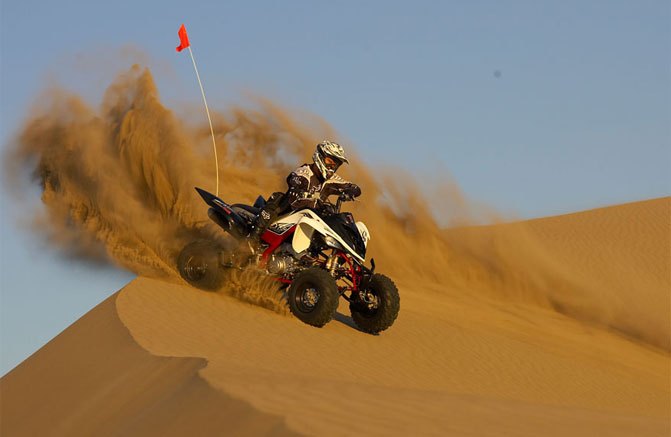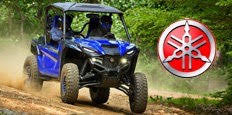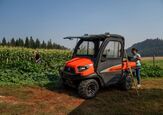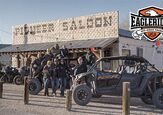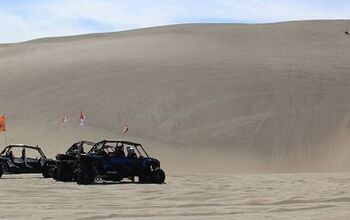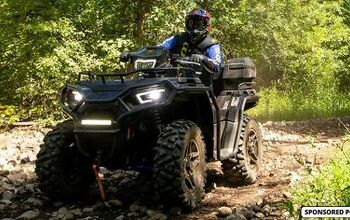How to Ride the Dunes
Ah yes…..it’s that time of the year, when the leaves are starting to turn from green to red and yellow, there is a certain chill in the air as the sun sets earlier in the evening sky, and tank tops and flip-flops are being replaced by hoodies and long pants – it’s DUNE SEASON!
For seasoned duners, the summer has gone on far too long, as toys of all kinds sit dormant in the garage or hidden under tarps, just waiting for their “pre season” tune-ups to signal the start of their favorite time of year. While little kids everywhere are full of Halloween candy and giddy with anticipation for Christman, the beginning of dune season has a similar effect on adults who can’t wait to run amok in the sandy hills of their favorite dunes.
With the beginning of dune season in full swing, we here at ATV.com thought that we would do our part to ensure everyone has a safe and fun-filled season – so here is a quick run-down of some important safety reminders to keep in mind as you head off into the sand for a weekend of fun with family and friends.
Helmet: The most important piece of safety advice I give to anyone when talking about the dunes (or any type of riding, for that matter) is not only obvious, but it’s also a law in the Imperial Sand Dune Recreation Area (ISDRA) – WEAR A HELMET. No one – and I mean no one – in our group goes out into the dunes or even for a ride around camp without a helmet on, especially when riding an ATV or dirtbike.
Even if you’re riding within the relative safety of a UTV, a helmet is a must.
“But Mooooooom I’m just going to be putting around camp!” is something I hear often from my kids, but I have always been taught that you always gear up for the unexpected; after all, no one expects to get into an accident – that is why they are called accidents. Being close to camp is no assurance that someone isn’t going to go flying by in a buggy and fail to see a child on a quad or bike.
I also go as far as to wear a helmet in my race Rhino when heading out into the dunes – not because I’m worried about rolling over in my (very safe) roll-cage – but because I want to be sure that if I’m ever involved in a serious, unexpected collision, that I am as protected as possible from whatever might happen. I would rather wear my helmet every day for no reason, than to have my family only wish that I had been wearing it the one time I needed it the most.
As parents, it’s our responsibility to make sure our children are geared up properly each and every time they head out for a ride. It’s also our responsibility to lead by example, and show our children the safest way to enjoy the dunes.
Protective Gear: Along with a helmet, those who ride quads or bikes can also benefit from much of the same safety gear that is used in racing MX. Chest protectors, fully supportive boots, long sleeves and pants can all aid in protecting a rider in the event of an accident. Anyone who has burned their bare leg on a glowing headpipe can also attest to the importance of wearing long pants, even on the hottest of days. Goggles or another form of eye protection are also extremely important, especially in a place like the dunes where blowing sand is a part of life.
Safety Flag: Another extremely important safety item to have with you any time you head into the dunes is a required (yes, it’s a law, too!) safety flag for every vehicle that will be driven in the sand. Also called a ‘whip’, a safety flag is flown a minimum of 8’ above the ground and is easily seen by anyone cresting a dune or coming across your path while riding in the sand. With its many hills and razorbacks, a safety whip is sometimes the only warning you will get that a vehicle is approaching from the opposite direction. Many duners have a lot of fun with these flags also, and it’s a way to personalize your vehicle while ensuring that you can be seen at all times.
A safety flag (or whip) is not only required, but it’s a great way to make sure you are noticed while riding the dunes. Let your freak flag fly!
Safety Belts: For the buggy and UTV crowd, proper safety restraints are also extremely important at the dunes. Most serious duners will install aftermarket four or five point harnesses, and any responsible duner will ensure that every harness and factory seat belt is fastened before heading out for even the shortest ride with friends or family.
It’s fun to share the duning experience with a big group, but it’s also a safe way to travel becuase somebody will be close by to help should you need it.
Safety in numbers: Unless you are an experienced duner, or you are in a situation where you have no choice, a good rule of thumb is to never ride alone. Inexperienced duners should never venture into the dunes alone, and even experienced duners generally travel in groups of two or more – and for good reason. If something were to happen to a lone rider in the middle of the dunes, it could be a matter of hours or even days before being discovered by another duner. With other riders present, if an accident or mechanical failure occurs, there is at least someone else around who can go find help.
Don’t drink and ride: An ATV or UTV is a vehicle, just like any other automobile, and drinking and riding is responsible for far too many accidents in the dunes. Don’t drink and ride! Not only is it illegal (yes, you can get a DUI in the dunes!), but it’s extremely irresponsible to ride intoxicated in an already risky environment, where you need every ounce of awareness to ensure a safe and good time for you and your family.
Use Your Head
All of the safety items in the world cannot take place of the most important thing anyone can take with them on a trip to the dunes – COMMON SENSE. It is vital that anytime you venture into a place as unpredictable as the dunes, that you not only know your own physical limitations, but those of whatever vehicle you are piloting. If you are driving a UTV, then be aware of the way your UTV was meant to be driven, and use caution at all times. If you are riding a quad or dirt bike, then be aware of the power your vehicle has (or doesn’t have), and drive it accordingly.
Sand dunes are big and constantly changing. It’s easy to get lost and disoriented, so if you’re new, make sure you tag along with an experienced rider.
One of the most important things I try to tell anyone who is new to the dunes is to “always expect the unexpected.” Being overconfident and letting your guard down, even for a moment, can have severe consequences, so it’s important to have the utmost respect for the dunes each and every time you venture out into the sand.
The dunes change constantly, and the path you used over and over the day before can suddenly become full of drop-offs and witches eyes (deep holes in the sand) overnight, or even after just a matter of hours on a windy day. Never assume you know what is over the hill you are cresting, and always be ready to react instantly in case you come across the unexpected, such as a drop-off, downed rider, abandoned vehicle or similar obstacle.
The most important thing is to have fun and enjoy yourself in your favorite adult-sized sandbox!
When traveling across the dunes, it’s a good rule of thumb to always follow an experienced rider who knows what they are doing, and who knows how to read the dunes. Not only can an inexperienced duner easily get lost, but they can quickly find themselves in a dangerous situation if they don’t know the best way to handle the steep faces and bowls of the bigger dunes
Have Fun Safely
In an effort to avoid this article becoming a full-fledged novel, we have barely tapped the most basic points to remember in order to have a safe and fun-filled experience at the dunes. As we mentioned before, the most important thing to take with you to the dunes is your common sense – use this in generous portions, and you should be able to enjoy the dunes and all they have to offer for many years to come.
Click here to see the rules for the ISDRA (Glamis Dunes). It’s important to understand the laws of the dunes before heading out for the first time, and it’s a great refresher course for experienced duners at the beginning of dune season!
More by ATV.com Staff





